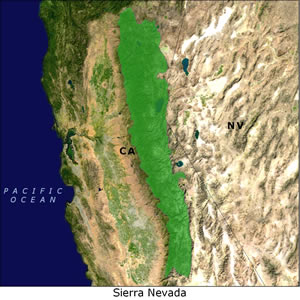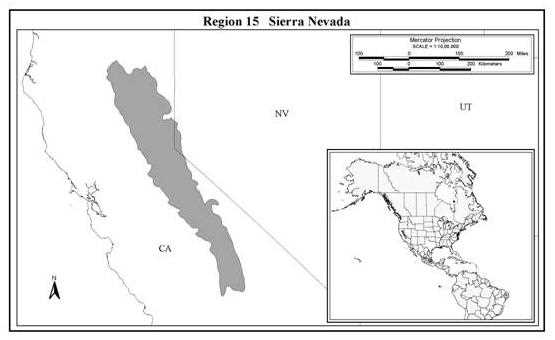Ducks Unlimited conservation priority area, providing waterfowl nesting habitat and watershed impacts within the Central Valley

A gentle western slope demarks the Sierra Nevada, rising out of the Central Valley, forming jagged peaks, and a steep eastern face that slopes into the Great Basin. From 300 to 3,000 feet, the vegetation is dominated by grassland or oak chaparral. Above 2,600 feet, pines begin to dominate, until alpine habitats are reached near the summit. The most important wetland habitats are associated with the major tributaries of the Sacramento and San Joaquin rivers. Grass Valley and Sierra Valley are perhaps the best palustrine wetland complexes in this region.

California | Nevada

A gentle western slope demarks the Sierra Nevada (Region 15*), rising out of the Central Valley, forming jagged peaks, and a steep eastern face that slopes into the Great Basin. From 100 to 1,000 m the vegetation is dominated by grassland or oak chaparral. Above 800 m pines begin to dominate, until alpine habitats are reached near the summit. The most important wetland habitats are associated with the major tributaries of the Sacramento and San Joaquin Rivers. Lacustrine marshes also existed around Lake Tahoe, but several have been degraded for home development. Grass Valley and Sierra Valley are perhaps the best palustrine wetland complexes in this region. Over 90% of the riparian corridors in California have been destroyed or modified (Gilmer et al. 1982). Urban expansion in the next 10-40 years will concentrate on the Valley and its foothills. The human population in California is expected to double in the next forty years.
This forested region is very important for neotropical songbirds, but is far less important for waterbirds. Mallard, wood duck, Canada goose and hooded merganser nest to 1,000 m, while bufflehead and common merganser nest at higher elevations. Foothill riparian wetlands are used during late winter and early spring, especially in wet winters. It is important to protect water quality, hydrologic flow patterns, and riparian corridors for watershed impacts within the Central Valley, but the Sierra Nevada region is of minor importance to the conservation efforts of DU.
*Region 15 - NABCI Bird Conservation Region 15
Ducks Unlimited uses cookies to enhance your browsing experience, optimize site functionality, analyze traffic, and deliver personalized advertising through third parties. By continuing to use this site, you agree to our use of cookies. View Privacy Policy